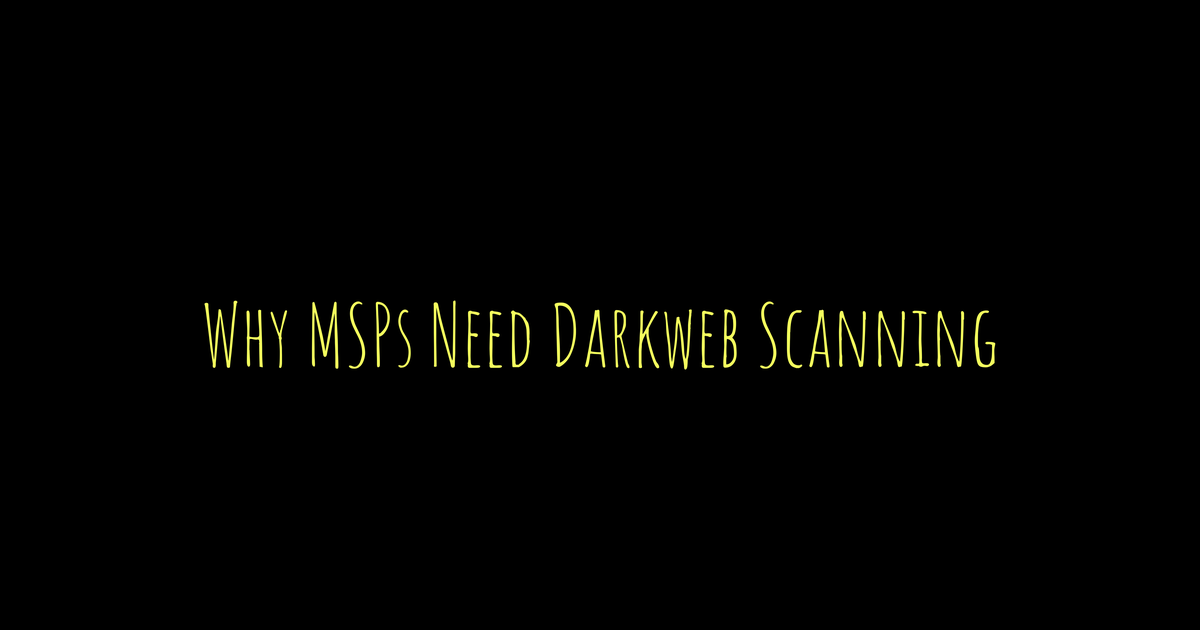Dark web scanning plays an important role for MSPs by helping them detect compromised credentials and leaked sensitive data early. With cyberattacks on the rise, especially those involving stolen passwords, MSPs need to be proactive in protecting their clients. This service lets MSPs spot risks before attackers exploit them, enabling faster response and stronger security measures like multi-factor authentication. Beyond enhancing client protection, dark web monitoring builds trust and loyalty since customers see their MSP as a serious cybersecurity partner. Plus, offering these scans creates new revenue opportunities and sets MSPs apart from competitors in a crowded market moving toward advanced threat detection solutions.
Table of Contents
- What Is Dark Web Breaches Scan and How It Works
- Why MSPs Should Monitor the Dark Web
- How Dark Web Scanning Protects MSP Clients
- Ways Dark Web Scanning Helps Prevent Cyberattacks
- Boosting MSP Revenue with Dark Web Monitoring
- Strategies for MSPs to Use Dark Web Scanning Effectively
- Frequently Asked Questions
7.1. What is darkweb scanning and why should MSPs use it?
7.2. How does darkweb scanning help MSPs improve security for their clients?
7.3. Can darkweb scanning detect all types of cyber threats facing MSP clients?
7.4. How often should MSPs perform darkweb scans for their clients?
7.5. What challenges do MSPs face when incorporating darkweb scanning into their services?
What Is Dark Web Breaches Scan and How It Works
Dark web breaches scan is a cybersecurity process that continuously searches the dark web for leaked or stolen sensitive information related to an organization or its clients. This includes exposed credentials such as usernames and passwords, intellectual property, personal information, and confidential business data. The dark web itself is a hidden part of the internet accessed through specialized browsers like Tor, where cybercriminals anonymously trade stolen data on marketplaces and forums. Automated tools and threat intelligence gather information from these sources, scanning for any data linked to a client or organization. When such information is detected, the system generates alerts to notify MSPs and their clients, allowing them to respond quickly before attackers can exploit the data. These scans are often integrated with existing security solutions, enhancing overall threat detection. Organizations can customize scanning settings to focus on specific data types or client environments, making the process more targeted and effective. Regular scanning is vital because new breaches and data leaks appear frequently, and cybercriminals constantly circulate stolen information, increasing the risk of attacks such as ransomware, identity theft, and financial fraud.
Why MSPs Should Monitor the Dark Web
Cyberattacks are increasing quickly, with global damages expected to reach $10.5 trillion by 2025. For Managed Service Providers (MSPs), this means staying ahead is crucial. Credential theft plays a role in 61% of breaches, and many people reuse passwords across accounts, which makes early detection vital. With remote work becoming common, 92% of remote workers use personal devices and 45% reuse passwords between work and personal accounts, expanding the attack surface significantly. Privileged accounts often lack strong security, making them key targets for attackers seeking broad access. The financial impact is severe, with average breach costs over $4.45 million globally and more than $5 million in the U.S., while ransomware damages average $4.54 million. MSPs act as frontline defenders, and integrating dark web monitoring helps them detect stolen credentials or leaked data early, allowing clients to respond before attacks escalate. Offering this service builds client trust by demonstrating a commitment to proactive and advanced security measures. It also differentiates MSPs from competitors by adding a specialized, high-value service that meets growing market demand. Ultimately, monitoring the dark web equips MSPs to protect clients more effectively and position themselves as trusted cybersecurity partners in a constantly evolving threat landscape.
| Key Metric | Statistic | Implication |
|---|---|---|
| Projected Cyberattack Damages by 2025 | $10.5 trillion | Highlights the growing threat landscape MSPs must address |
| Percentage of Breaches Involving Stolen Credentials | 61% | Credential theft is a top cause of cyberattacks, emphasizing the need for monitoring |
| Password Reuse Across Sites | 85% of users | Increases vulnerability to multiple breaches from a single leak |
| Remote Worker Security Risks | 92% use personal devices; 45% reuse passwords | Expanded attack surfaces make proactive detection critical |
| Average Cost of Data Breach Globally (2023) | $4.45 million | High financial stakes justify investment in early detection |
| Average Cost of Data Breach in the U.S. | Over $5 million | Significant impact on organizations underlining need for protection |
| Average Financial Impact of Ransomware Attacks | $4.54 million | Ransomware costs reinforce value of early threat detection |
| Market Demand for Dark Web Threat Intelligence | 65% of MSSPs report growth; 74% increased client interest | Rising demand creates opportunity for MSP service expansion |
| MSSPs Offering Dark Web Monitoring | 56% | Majority are integrating this service, indicating competitive advantage |
How Dark Web Scanning Protects MSP Clients
Dark web scanning provides MSP clients with continuous monitoring that helps identify leaked credentials and sensitive data early, giving them a crucial head start to respond swiftly. When exposed information is detected, MSPs can alert clients to enforce stronger security measures like multi-factor authentication and prompt password changes, which significantly reduce the risk of attacks that often begin with stolen credentials, such as ransomware. The intelligence gained from dark web monitoring also enhances incident response by offering actionable insights, allowing clients to contain and remediate breaches more quickly and effectively. By integrating dark web data with endpoint detection tools and SIEM platforms, MSPs create a layered defense that improves overall security posture. Customizable alerts ensure notifications match each client’s risk level and industry requirements, while regular reporting supports compliance by documenting exposure and response efforts. This visibility helps clients prioritize vulnerabilities and allocate resources efficiently, supporting ongoing threat hunting and continuous security improvements. Ultimately, early warnings from dark web scanning help clients avoid costly downtime and protect their reputation, making it an essential part of proactive cybersecurity management for MSPs and their clients.
- Continuous monitoring identifies leaked credentials and sensitive data early, enabling clients to respond swiftly.
- Alerts about exposed information help clients enforce stronger security measures like multi-factor authentication and password updates.
- Timely detection reduces the risk of ransomware and other attacks that often start with stolen credentials.
- Dark web intelligence enhances incident response by providing actionable insights to contain and remediate breaches faster.
- Integration with endpoint detection and SIEM platforms creates a layered security approach, improving overall defense.
- Customizable alerts allow MSPs to tailor notifications based on client risk levels and industry requirements.
- Regular reporting supports compliance efforts by documenting threat exposure and response actions.
- Clients can prioritize vulnerabilities and focus resources effectively with clear visibility into their data exposure.
- Dark web scanning supports proactive threat hunting and continuous security improvements.
- By providing early warnings, MSPs help clients avoid costly downtime and reputational damage.
Ways Dark Web Scanning Helps Prevent Cyberattacks
Dark web scanning plays a crucial role in stopping cyberattacks before they can cause damage. One of its biggest benefits is the early detection of stolen credentials, which prevents attackers from using leaked usernames and passwords to break into client systems. This early warning allows MSPs to prompt rapid password resets and revoke access, cutting off attackers before they exploit the data. Additionally, identifying exposed personal and business information helps clients address weak security points, strengthening their overall defenses. Alerts generated from dark web monitoring encourage clients to review and tighten identity and access management controls, which reduces the risk of unauthorized access. The intelligence gathered from these scans also supports phishing prevention by revealing compromised email addresses that cybercriminals use in scams. Beyond external threats, dark web scanning can uncover insider risks by spotting data exposure originating within the organization. It also helps clients monitor third-party and vendor risks, as leaks associated with extended networks can be identified early. Furthermore, this service enables tracking of ransomware gangs and emerging attack trends circulating on the dark web, giving MSPs and clients vital context to prepare defenses. Regular scanning reduces the attack surface by closing gaps before criminals exploit them, and when combined with other security tools, it forms a more complete defense strategy. In practice, this means MSPs can deliver stronger protection through proactive, intelligence-driven actions that help clients avoid costly breaches and maintain trust.
Boosting MSP Revenue with Dark Web Monitoring
Offering dark web monitoring allows MSPs to create new service packages centered on breach detection and prevention, opening fresh revenue streams. By bundling dark web scans with endpoint security, log monitoring, and threat intelligence, MSPs can deliver premium, comprehensive cybersecurity offerings that meet the increasing client demand for advanced protection. Showing clients how this service can prevent costly data breaches provides a strong case for higher fees and improves service renewal rates. With the dark web intelligence market projected to reach $1.3 billion by 2028 at a 22.3% CAGR, MSPs have a growing opportunity to capitalize on this trend. Using dark web scanning as a marketing differentiator helps attract security-conscious clients who prioritize proactive defenses. Additionally, offering free trials or demos encourages prospects to experience the value firsthand, easing the path to paid subscriptions. Upselling dark web monitoring to existing customers boosts recurring revenue while tailored alerts and detailed reporting enhance perceived value, supporting premium pricing. Integrating this service into managed security offerings positions MSPs as trusted cybersecurity partners, strengthening client relationships and driving long-term business growth.
Strategies for MSPs to Use Dark Web Scanning Effectively
MSPs can maximize the value of dark web scanning by adopting third-party monitoring platforms that reduce costs and speed up deployment without requiring heavy internal resources. Bundling dark web scans with existing services like endpoint protection, backup, and threat intelligence creates a comprehensive security package that appeals to clients seeking all-in-one solutions. Educating clients on the dangers of credential theft and the benefits of early detection helps build awareness and encourages proactive security behavior. Customizing alerts and reports to fit each client’s industry, size, and risk profile ensures the intelligence provided is relevant and actionable. Using findings from scans during sales conversations provides concrete examples of real threats, helping justify cybersecurity investments. Staying informed on evolving dark web trends and emerging breaches allows MSPs to keep their protection measures current and effective. Regularly reviewing scan results supports continuous improvement of client security posture. Coordinating dark web monitoring with incident response teams accelerates remediation when leaks are detected, minimizing potential damage. Leveraging automation helps filter out false positives, enabling MSPs to focus on critical threats that need immediate attention. Positioning dark web monitoring as a proactive service complements reactive cybersecurity efforts, reinforcing the MSP’s role as a trusted security partner.
Frequently Asked Questions
1. What is darkweb scanning and why should MSPs use it?
Darkweb scanning is the process of searching the hidden parts of the internet for exposed data or threats. MSPs should use it to proactively find compromised credentials or sensitive information related to their clients before criminals exploit it.
2. How does darkweb scanning help MSPs improve security for their clients?
By uncovering leaked credentials, personal data, or vulnerabilities early, MSPs can alert clients to take action, such as changing passwords or tightening defenses. This reduces the risk of data breaches and keeps client environments safer.
3. Can darkweb scanning detect all types of cyber threats facing MSP clients?
No, darkweb scanning primarily finds exposed or stolen data but does not catch every type of cyber threat like malware or phishing attacks. It’s one important layer within a broader security strategy MSPs should maintain.
4. How often should MSPs perform darkweb scans for their clients?
Frequency depends on the client’s risk level, but regular scanning, such as weekly or monthly, helps catch new leaks quickly and respond before damage is done. Some MSPs integrate continuous monitoring tools to stay updated in real time.
5. What challenges do MSPs face when incorporating darkweb scanning into their services?
Challenges include interpreting large amounts of data, prioritizing genuine risks from false positives, and ensuring client data privacy. MSPs also need expertise to act on findings effectively and integrate scanning results into overall security workflows.
TL;DR Dark web scanning helps MSPs detect stolen credentials and sensitive data early by monitoring the hidden parts of the internet where cybercriminals trade this information. With cyber threats rising and credential theft being a common attack vector, MSPs can use dark web monitoring to protect clients from costly breaches, strengthen trust, and stand out from competitors. This service also opens new revenue opportunities by meeting growing demand for advanced cybersecurity. For best results, MSPs should integrate dark web scanning with other security tools, educate clients on risks, and customize alerts to provide timely, actionable intelligence that supports proactive defense and incident response.





